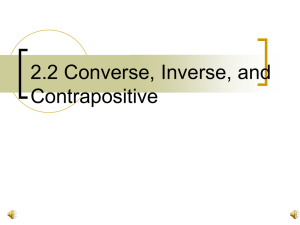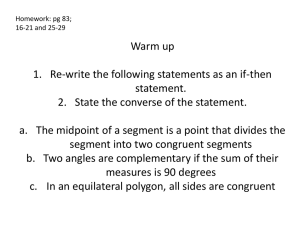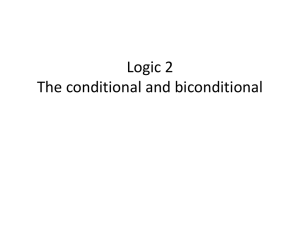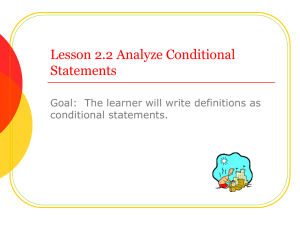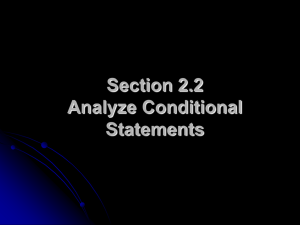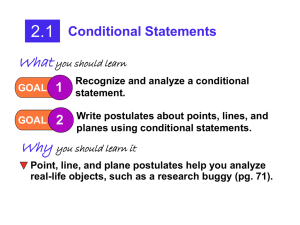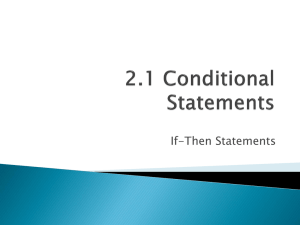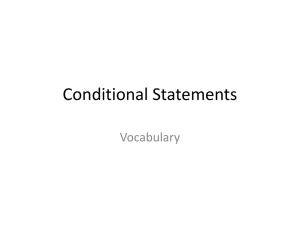6.2 Inverses and Contrapositives
advertisement
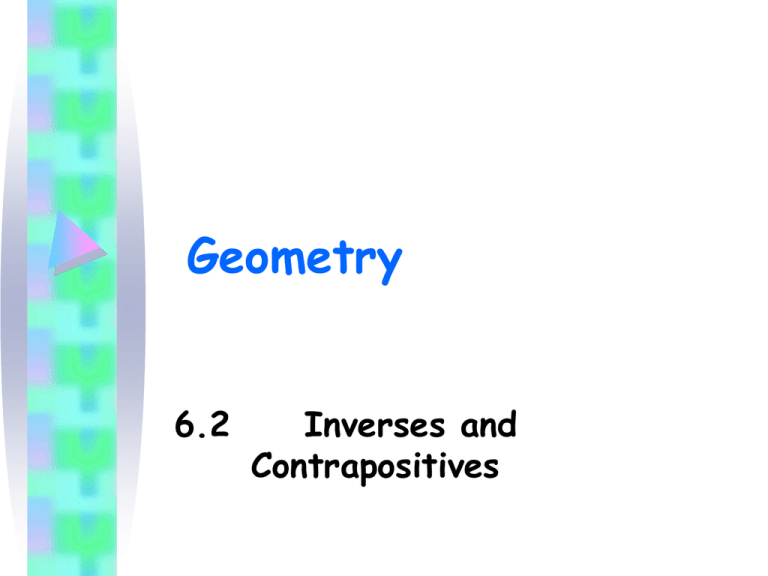
Geometry 6.2 Inverses and Contrapositives There are two other types of conditionals called the inverse and the contrapositive. Recall: Conditional Statement IF ________________ Converse of Conditional IF ________________ Contrapositive IF _________________________ Inverse IF _________________________P (if)Q (then) Adding “not” to a statement is called ______________ the statement. Here are some other examples with their negation. p not p not q is parallel is even = Venn diagrams can represent conditionals and can be very helpful in understanding conditional statements. If an item is in circle p it is also in circle q. if p then q (conditional) Also, if an item is not in circle q then it is not in circle p. if not q then not p (contrapositive) Thus, the conditional and the contrapositive are said to be ___________________ statements. If the conditional is true, then the contrapositive is ________. Since they are the same, you can prove a conditional by proving its contrapositive! Sometimes this is actually easier than proving the conditional itself. The Venn diagram on the right represents the converse and the inverse. If an item is in circle q then it is in circle p. if q then p (converse) If an item is not in circle p then it is not in circle q. if not p then not q (inverse) For this reason, the converse and inverse are ___________________ statements. If the converse is true, then the inverse is _________. To summarize all possible relationships between conditionals: Conditional Contrapositive Converse Inverse Sometimes we have to re-word a statement from standard English to fit If-Then form. All squares are rhombuses If ____________________________________ All marathoners have stamina If ______________________________________ Sample problems: Write the contrapositive, converse and inverse of each conditional. If 2x + 1 = 7, then x = 3. Contrapositive:________________________________________________________ Converse:____________________________________________________________ Inverse:_____________________________________________________________ If a polygon has five sides, then it is a pentagon Contrapositive:________________________________________________________ Converse:____________________________________________________________ Inverse:_____________________________________________________________ Classify each conditional as true or false. Give its converse, inverse and contrapositive. Then state if each is T/F? If a triangle is isosceles, then it is equilateral. Conv______________________________________________________ Inv_______________________________________________________ Contra____________________________________________________ If mA 90, then A is not a right angle. Conv______________________________________________________ Inv_______________________________________________________ Contra____________________________________________________ If today is February 29, then tomorrow is March 1 Conv______________________________________________________ Inv_______________________________________________________ Contra____________________________________________________ Assume the given statement is true.What can you conclude by using the given statement together which each additional statement? If no conclusion is possible, say so. \If WXYZ is a rhombus, then its diagonals are perpendicular All poets are philosophers. a. W Y X Z a. Jose is a poet b. WXYZ is a square b. Jane is a philosopher c. mXWY + mWXZ = 100 c. Jung is not a poet. d. WXYZ is not a rhombus d. Jean is not a philosopher. Homework Pg. 211 WE #5-10, (11-19 odd) Reviewing Conditional Statements Your Dad says, “If you get a B average, then you can get your driver’s license.” This is an example of an if-then statement, which is also called a conditional. You have already learned about the converse of a conditional. It is formed by interchanging the hypothesis and the conclusion. Converse The converse of a conditional is formed by switching the hypothesis and the conclusion: Statement: If p, then q. Converse: If q, then p. hypothesis conclusion Today you will learn about other related conditionals……. the inverse the contrapositive GIVEN STATEMENT: If p, then q. INVERSE: If not p, then not q. Inverse negates given statement. CONVERSE: If q, then p. CONTRAPOSITIVE: If not q, then not p. Contrapositive negates converse. GIVEN STATEMENT: If p, then q. If today is Tuesday, then tomorrow is Wednesday. INVERSE: If not p, then not q. If today is not Tuesday, then tomorrow is not Wednesday. CONVERSE: If q, then p. If tomorrow is Wednesday, then today is Tuesday. CONTRAPOSITIVE: If not q, then not p. If tomorrow is not Wednesday, then today is not Tuesday. A statement and its contrapositive are logically equivalent (either both true or both false.) Statement: Q P If p, then q. Contrapositive: If not q, then not p. The converse and the inverse are also logically equivalent (either both true or both false.) P Q Converse: If q, then p. Inverse: If not p, then not q. A statement is NOT Q logically equivalent to its converse or to its inverse. Statement: P If p, then q. True Converse: If q, then p. Not true! Inverse: If not p, then not q. Not true! Example Suppose this conditional is true: All runners are athletes. (If a person is a runner, then that person is an athlete.) What can you conclude about each additional statement? 1. Steven is a runner. 2. Sally is not an athlete. 3. Susan is an athlete. 4. Stan is not a runner. Venn diagrams can be useful to illustrate. Sally Statement: All runners are athletes. Athletes ? Steven is a runner. So, Steven is an athlete. Runners Steven Sally is not an athlete. ? So, Sally is not a runner. Susan is an athlete. No conclusion follows. Stan is not a runner. No conclusion follows. ? Susan Stan ? Classify the statement as true or false. Then give the following, and classify each as true or false: (a) converse (switch p and q ) (b) inverse (negate the statement) (c) contrapositive (negate the converse) If two lines are parallel, then they do not intersect. True (a) converse: If two lines do not intersect, then they are parallel. False (b) inverse: If two lines are not parallel, then they intersect. False (c) contrapositive: If two lines intersect, then they are not parallel. True Classify the statement as true or false. Then give the following, and classify each as true or false: (a) converse (switch p and q ) (b) inverse (negate the statement) (c) contrapositive (negate the converse) If two angles are acute, then they are complementary. False (a) converse: If two angles are complementary, then they are acute. True (b) inverse: If two angles are not acute, then they are not complementary. True (c) contrapositive: If two angles are not complementary, then they are not acute. False Turn to page 210 Let’s talk through CE #1 together Turn to page 211 Let’s talk through WE #6 together
